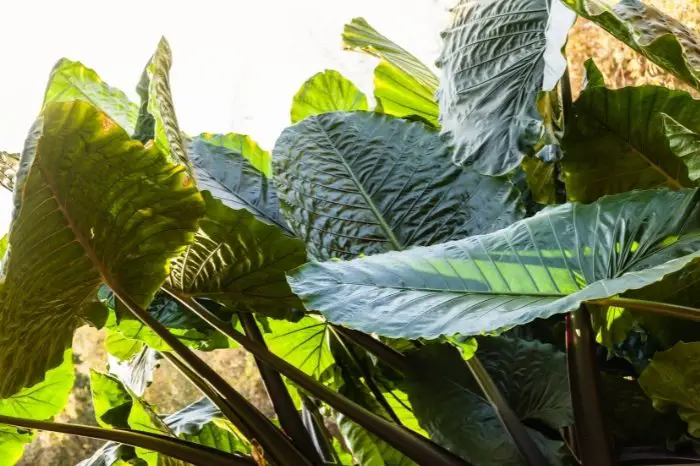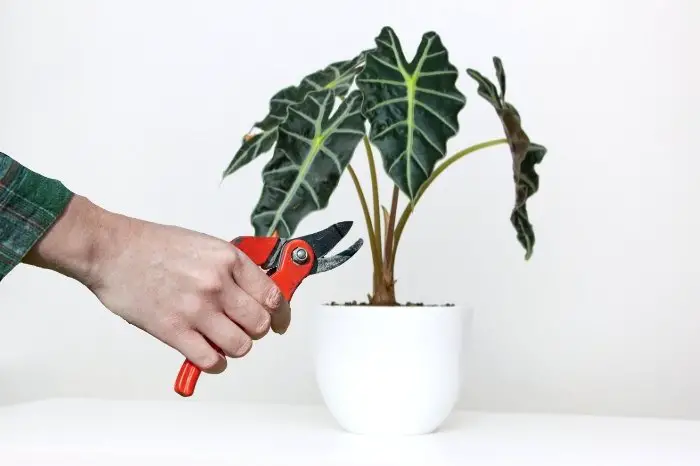Last Updated on May 19, 2022
Alocasia sinuata is a rare type of plant that can be a nice addition to your indoor space. All you need d is to care for this plant adequately and enjoy its beauty in your indoor space such as homes and offices.
This plant is characterized by its lush foliage that looks broad, shiny, and dark green. It tends to be a compact plant making them the best candidate for indoor propagation.
Alocasia sinuata is a must have if you’re a lover of indoor houseplants because they tend to look pretty good in an indoor setting.
So, to enjoy this plant, you need to know how to properly maintain it. This is why we will be discussing how you can take care of this stunning plant. We will also talk briefly about their propagation so let’s begin.
Alocasia Sinuata General Care Guide
Properly caring for alocasia sinuata plant gives it a better chance for the plant to grow fast and optimally. So, below is the general care guide for this plant:
1. Light Requirement
The light requirement for alocasia sinuata is bright indirect sunlight so this means the plant will do well under bright shade.
Their outdoor growing nature is under canopied trees and this has made them evolved to plant that can thrive in low light conditions and with little direct sun exposure. Therefore, growing alocasia indoors is fine if you can provide the plant with bright light. You can as well make use of bright artificial indoor grow lights.

If you expose this plant to too much direct sun, their leaves begin to wilt, the color fades, and can exhibit curled leaves with burned edges.
Too little sun exposure on the other hand can cause drooping of leaves and the plant may begin to bend or stretch towards the direction of sunlight as it tries to get light. To help the plant in this situation, ensure you always rotate the plant so it can obtain equal sun exposure.
2. Watering Requirements
It is very crucial you get the correct watering scheme for this plant. It can die of excess water but the soil also needs to be a bit damp.
You can do a simple test by inserting your finger into the soil to check for soil moisture when you want to water it. Check about one inch of the soil with your finger and if the soil feels dry then it’s time to water your plant.
When watering, water the plant evenly and make sure at least 2 to 3 inches of the soil is dry before you water.
3. Soil
The best soil conditions for alocasia sinuata plants is a well-aerated, crumbly, and fast-draining soil. Maintain moist soil but avoid over-watered soil. If your soil is soggy, it can predispose the plant to infections and even cause root rot.
For a proper soil combination for alocasia sinuata, you can mix sand with cocopeat.
4. Fertilization
During the growing season of alocasia sinuata (which is spring and summer), they tend to feed heavily. A good fertilizing plan is using liquid fertilizer or a little portion of granular fertilizers.
You can use a balanced fertilizer but we recommend using it with a higher nitrogen value so that the plant can grow bountifully.
Plant Food Indoor Plant Food Liquid Fertilizer for Philodendron Micans
So, during their growing season, you should fertilize every 2 to 3 weeks. However, when the plant is in its dormant period, don’t fertilize them.
5. Humidity
Alocasia sinuata flourish under high humidity and higher humidity can help prevent spider mites that are the most common pest of alocasia sinuata.
6. Temperature
Alocasia sinuata thrives well with warm temperatures. The ideal temperature to grow alocasia sinuata is around 60 to 80 degrees Fahrenheit. When the temperature dips below this range or during extreme conditions such as winter, the plant tends to enter dormancy.
Therefore, it is crucial you avoid putting your alocasia sinuata plant close to heaters or air conditioners. This can prevent extreme temperature variations.
Check Out All You Need To Know About Sansevieria Night Owl
7. Potting
Because of the natural compact habitat, alocasia sinuata prefers a relatively smaller pot that fits their size. If you use a big pot, the plant can grow in an unhealthy manner.
8. Trimming
Trimming your plant encourages healthier and faster growth. When you trim off damaged or diseased parts of the plant, it can help reduce or stop the spread of fungal infections or pests.

Alocasia Sinuata Propagation
Propagating alocasia sinuata is pretty easy so if you wish to have more of this lovely plant, you can always propagate it. There are various ways of propagating alocasia sinuata and some of them include;
1. Division Of Alocasia Sinuata
This method involves carefully dividing the rhizome of the plant into two equal parts. One of the parts is placed into a separate pot and it will re-grow into a complete plant.
2. Propagation Through Offset
You can propagate alocasia sinuata through offset by simply separating the baby plant from the mother plant. Then you repot the baby plant separately.
3. Seed Propagation Of Alocasia Sinuata
The seeds of alocasia sinuata are isolated and soaked overnight. Then sow the damp seeds quarter an inch into a pot. Take note not to dry the seeds because this can reduce the viability of the seeds. We recommend you sow your seeds in the fall season.
Then maintain optimal conditions (such as indirect sun, moisture, high humidity, warmth, and so on) for your newly potted plant.
Final Remark
Alocasia sinuata is a nice plant that is easy to take care of and you can always enjoy the beautiful nature of this plant wherever you place it in your indoor space. Propagating alocasia sinuata is also fairly easy if you get the proper knowledge.
FAQ’s
Is alocasia Sinuata rare?
Yes, alocasia sinuata is indeed a rare type of plant and it is endemic to the Philippines. Alocasia sinuata falls under the species of plant that is seriously endangered.
How do you care for alocasia Sinuata?
It is easy to care for alocasia sinuata and you can do this by providing bright indirect sunlight to the plant. Other care to give the plant also includes high humidity, warm temperature, damp soil, pruning, and fertilization.
Does Alocasia need water?
Yes, alocasia requires water to grow and it needs the plant's soil to be mosit. However, you should ensure the plant isn’t water-logged because this can predispose the plant to infections and root rot.
What is the rarest Alocasia?
The rarest Alocasia species is Alocasia Azlanii or Red Mambo. This type of Alocasia is a very unique and attractive species that has its leaves that appear to be dark purple with red or pinkish veins.

Eunice is an enthusiastic gardener with a passion for growing beautiful flowers. She loves nothing more than spending time in her garden, tending to her plants and enjoying the outdoors. Eunice has been gardening for over 15 years and has developed a unique style of landscaping that is both practical and aesthetically pleasing. She is especially fond of growing roses and enjoys experimenting with different varieties and colors. Eunice takes great pride in her garden and often shares the fruits of her labor with friends and family. In her spare time, she enjoys reading gardening magazines and attending local horticulture events. Eunice is passionate about her hobby and is always eager to share her knowledge and experience with others.

